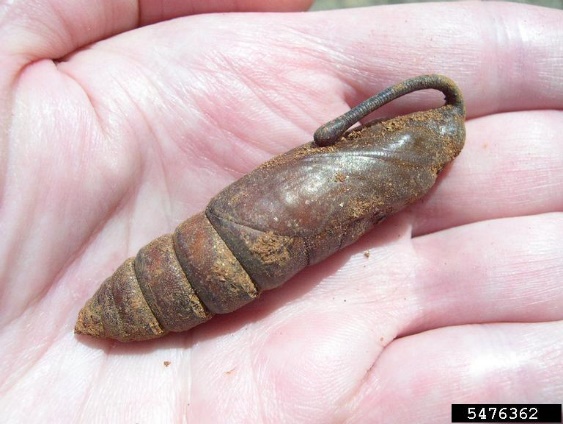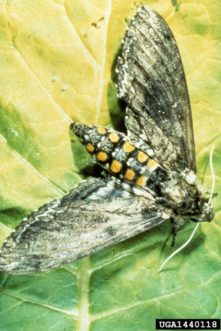Introduction
The tobacco hornworm (Manduca sexta, THW) is a pest of a number of plants in the Nightshade family (Solanaceae), including tomato, tobacco, eggplant, pepper, and potato. Because of the patterns along the abdomen of the moth and their fast, hovering flying abilities, moths from this family (Sphingidae) are sometimes referred to as hawkmoths, hummingbird moths, or sphinx moths. The THW is one of the most consistent pests of flue-cured tobacco in the US.1,2 Protection from feeding by insects throughout the season is vital for growers of a high-value crop like tobacco to produce adequate yields, particularly as the THW feeds on the portion of the crop (leaves) that is harvested.
Identification
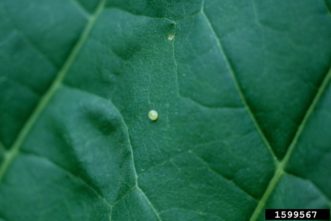
Figure 1. Tobacco hornworm egg. Photo credit: John C. French Sr., Retired, Auburn University, University of Georgia, Clemson University, University of Missouri. Bugwood.org.
The eggs of THW are spherical to oval, and smooth, ~1.5 mm (0.059 inches) in length, with the color varying from light green to yellow (figure 1).3 While newly hatched larvae are yellowish white, they quickly turn green for the rest of their development (figure 2). Larvae are characterized by a white strip on each segment, with also a fainter black stripe next to each white strip visible at the larvae grow.3 The pupa is reddish brown with a hook-like structure that contains the future moth’s mouthparts (figure 3).3 The adult is a moth (76 to 127 mm [3 to 5 inches] wingspan), with larger front wings than hind wings.3 Their general color is dark grey and brown, with orange spots on the abdomen (figure 4).
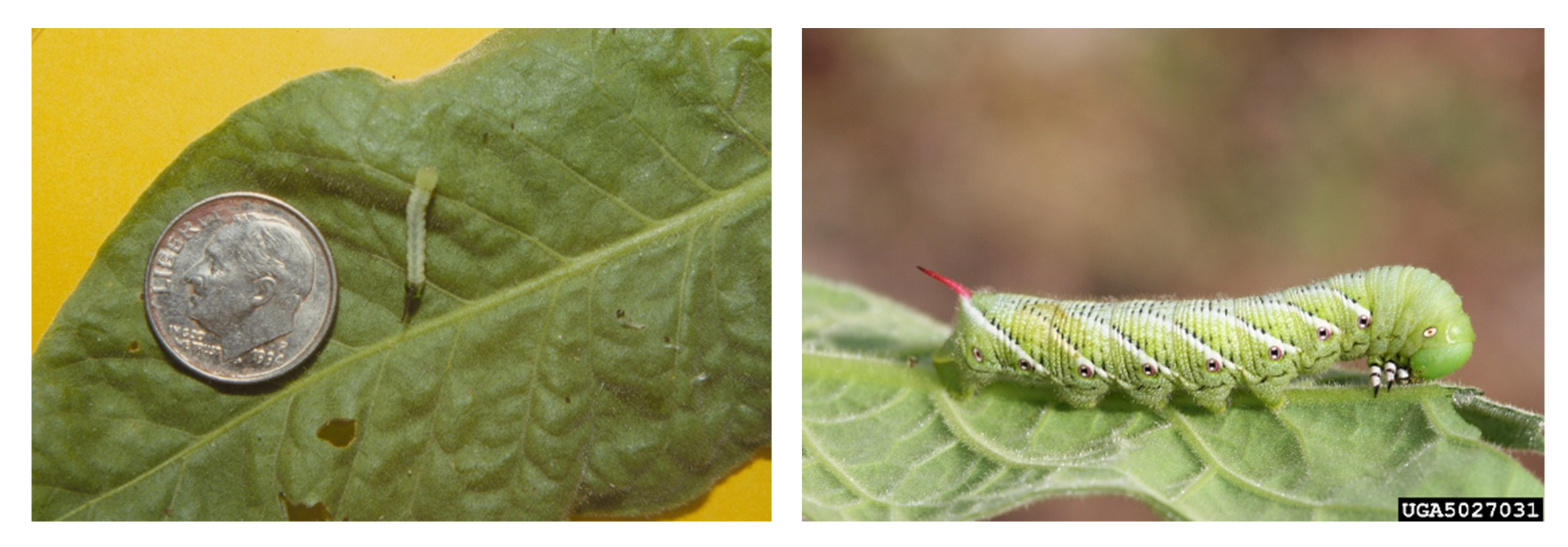
Figure 2. Newly hatched (left) and older (right) tobacco hornworm larva. Photo credit: Robert M. McPherson (left) and Eddie McGriff (right), University of Georgia, Bugwood.org.
Life Cycle
The insect overwinters as a pupa in the ground. Moths emerge beginning in May and can be found in South Carolina until September.4,5 Two to three generations of THW occur in South Carolina. Eggs are laid on the underside of leaves, with an average of 250 eggs laid per female.3 Duration of the larval stage averages twenty days, though this can range from thirteen to forty-four days depending on temperature.3 Pupal depth in the soil averages 5.5 inches, and the length of the pupal period averages 137 days (range of 14 to 405 days).3 Male moths can live from one to nineteen days, with an average of 6.7 days. Female moths can live from one to nineteen days, with an average of 8.8 days. Populations generally increase as the season progresses, with highest numbers of moths in the fall.4,5
Injury to Tobacco
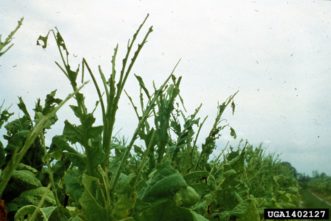
Figure 5. Tobacco hornworm damage to flue-cured tobacco. Photo credit: R.J. Reynolds Tobacco Company Slide Set, R.J. Reynolds Tobacco Company, Bugwood.org.
The THW is a defoliator and typically begins feeding on the upper leaves of a plant.2 Damage by THW leads to weight loss by defoliation, rather than reduced leaf quality.6 As the tobacco plant ages, it becomes more tolerant of THW feeding.2 If no control action is taken, THW can completely defoliate a tobacco plant (figure 5).
Management
Insecticides and Economic Thresholds
Although THW can cause major yield loss in tobacco, the insect can fortunately be effectively controlled with a range of insecticides. These include several formulations of Bacillus thuringiensis (Bt) (Javelin, DiPel, etc.), chlorantraniliprole (Coragen), cyantraniliprole (Exirel for foliar applications and Verimark for tray drench/transplant water applications), emamectin benzoate (Denim), acephate (Orthene), and spinosad (Blackhawk). The two insecticides chlorantraniliprole and cyantraniliprole belong to the anthranilic diamide class of insecticides and have systemic activity by root uptake against lepidopteran pests. These insecticides can be used as a tray drench to seedlings in the greenhouse or in transplant water, which allows the roots to absorb the insecticide. Trials at the Clemson University Pee Dee Research and Education Center near Florence, SC, have shown six to eight weeks activity after transplant with either chlorantraniliprole or cyantraniliprole, though residual activity varies with environmental conditions. Sufficient moisture in the soil is also needed for the plant to absorb the insecticide. An infestation level of ten or more larvae per one hundred plants (10%) indicates that the economic threshold has been reached, and an insecticide application is economically justified. Please see the Clemson University Pest Management Handbook for up-to-date control options and pesticide recommendations.
Biological Control
Natural enemies of THW can cause high levels of larval mortality in the field. One of the most common natural enemies is the Braconid wasp parasitoid Cotesia congregata, which has very visible white cocoons on parasitized THW larvae (figure 6). The adult parasitoid lays an average of sixty-five eggs in THW larva, with a range of 5 to 126 eggs.7 After feeding inside the THW host, larvae emerge to form pupae in a white cocoon from which a wasp will emerge. Parasitized THW larvae will eat less tobacco leaf, which should be taken into consideration when sampling for making a management decision. Another common natural enemy is the spined stilt bug, Jalysus wickhami. Biological control agents can cause >90% mortality of THW,8 underlining the need to minimize the use of broad-spectrum insecticides to preserve natural enemies.
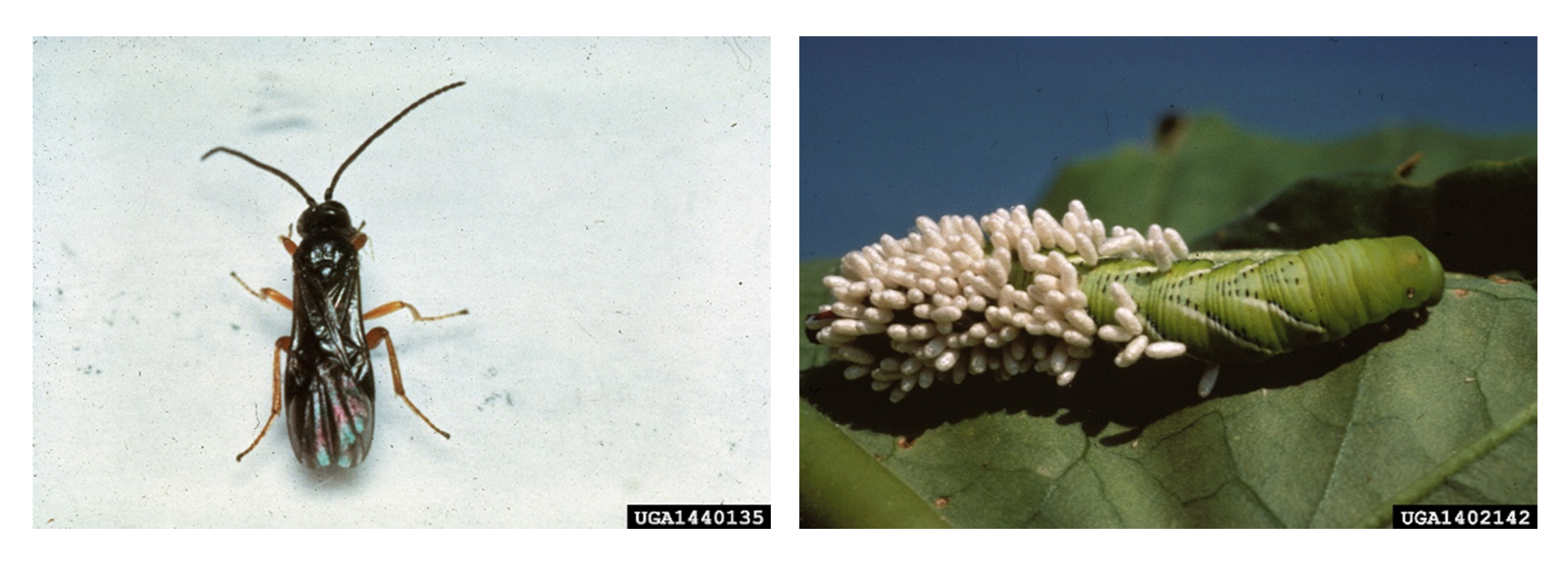
Figure 6. Cotesia congregata adult (left) and larvae in white cocoons on a tobacco hornworm (right). Photo credit: R.J. Reynolds Tobacco Company Slide Set, R.J. Reynolds Tobacco Company, Bugwood.org.
Cultural Practices
During the cropping season, good sucker control can help to reduce populations of THW on post-harvest tobacco.9 After harvest, destruction of crop residue (stalks and roots) can help to reduce overwintering populations of THW.10 Excessive nitrogen fertilization should be avoided, as it can make tobacco plants more attractive to THW.11
Summary
The THW is a common pest of tobacco in the US managed with insecticides, and infestations can be reduced by following specific cultural practices. If left untreated, tobacco plants can be completely defoliated under heavy THW pressure.
References Cited
- Johnson AW. Resistance in tobacco to the tobacco hornworm. Journal of Economic Entomology. 1979; 72:914–915.
- Kolodny-Hirsch DM, Harrison FP. Yield loss relationships of tobacco and tomato hornworms (Lepidoptera: Sphingidae) at several growth stages of Maryland tobacco. Journal of Economic Entomology. 1986; 79:731–735.
- Madden AH, Chamberlin FS. Biology of the tobacco hornworm in the southern cigar-tobacco district. United States Department of Agriculture Technical Bulletin. 1945:896.
- Holman JR, King EW. Effect of pre-emergence rainfall on population size in the tobacco hornworm. Journal of Economic Entomology. 1966;59(5):1199–1200.
- Roach SH, Whisnant FF. Seasonal captures of some economically important lepidopterous species in the coastal plain area of South Carolina in a 15W blacklight trap. Journal of Agricultural Entomology (USA). 1986; 3(3):280–285.
- Lawson FR, Rabb RL. Factors controlling hornworm damage to tobacco and methods of predicting outbreaks. Tobacco Science. 1964; 8:145–149.
- Lawrence SE. 2010. Feeding behaviors of larval Manduca sexta parasitized by Cotesia congregata [master’s thesis]. [Binghamton (NY)]: Binghamton University, State University of New York; 2010.
- Lawson FR. The natural enemies of the hornworms on tobacco (Lepidoptera: Sphingidae). Annals of the Entomological Society of America. 1959; 52:741–755.
- Rabb RL, Neunzig HH, Marshall HV, Jr. Effect of certain cultural practices on the abundance of tobacco hornworms, tobacco budworms, and corn earworms on tobacco after harvest. Journal of Economic Entomology. 1964; 57:791–792.
- Kinard WS, Henneberry TJ, Allen N. Tobacco stalk cutting: effect on insect populations. 1972; 65:1417–1421.
- Reagan TE, Rabb RL, Collins WK. Selected cultural practices as affecting production of tobacco hornworms on tobacco. Journal of Economic Entomology. 1978; 71:79–82.

